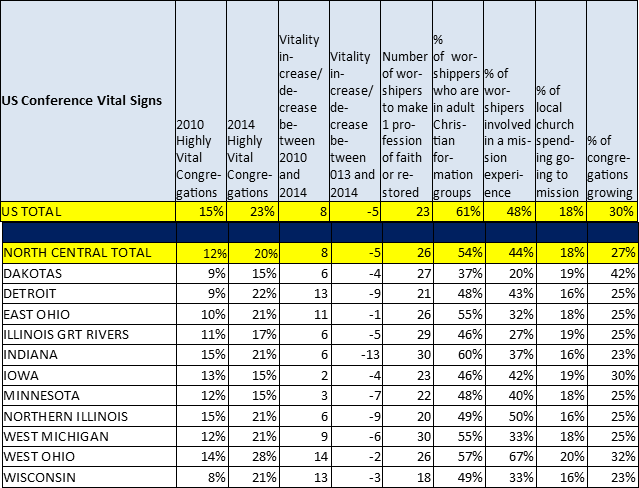New Jersey Area Bishop John Schol has released the 2014 Vitality Report on U.S. United Methodist churches.
Between 2013 and 2014, the report said, a higher percentage of United Methodists got involved in small groups and became engaged in mission. The report also shows congregations giving more to mission. However, it shows a decrease in the percentage of U.S. churches that are growing in worship attendance.
Highly vital congregations are focused on growing their vitality by making and maturing disciples, not achieving numbers. Highly vital congregations grow and support disciples and leaders through worship, small groups, lay and clergy leadership development and ministry and mission engagement.
Highly vital congregations are in every geographic region of the U.S. and are of all sizes and ethnicity. Vital Congregations is a broad based movement within the church that is making disciples and transforming the world.
The UMC began to measure vitality in the U.S. in 2010 and the latest 2014 vitality indicators show we are ahead of 2010 by 8 percentage points. We have made important progress in growing congregational vitality. Ultimately Vital Congregations is about changed lives and transformed communities.
There are hopeful signs and we still have challenges maintaining congregational vitality. Between 2013 and 2014, the latest vitality indicators show a 5 percentage point decrease in the percentage of highly Vital Congregations. But in 2014, three of the five markers of vitality increased.
- Increased the percentage of worshipers in small groups from 59% to 61%
- Increased the percentage of worshipers engaged in hands on mission from 38% to 48%
- Increased the average percentage of a congregation’s giving to mission from 15% to 18%
- Number of worshipers to make one profession of faith went from 22 to 23 (this is actually a decline because a lower number is preferable in this measure)
- Percentage of congregations growing in worship attendance decreased from 31% to 30%
While we can celebrate that we have made important progress between 2010 and 2014 in the percentage of Highly Vital Congregations and that three of the five markers of vitality increased during 2014, we also need to face into the challenge of the decrease in vitality between 2013 and 2014 largely driven by decreases in professions of faith and worship attendance.
We can also celebrate the progress we made in 2014 in three of the markers of vitality – small groups, mission engagement and mission giving. I believe that as we continue to grow in these areas, we will begin to experience healthier increases by more congregations in worship attendance and professions of faith.
The North Central Jurisdiction, that includes the Detroit and West Michigan conference is charted here: 
These are the specific measures used to identify highly vital congregations. To be considered as a highly vital congregation, a church must be in the top 25% of all congregations in two of the four major areas and cannot be in the bottom 25% in any one of the areas. Each specific measure is important as a highly vital congregation may not be as fruitful in every area but is fruitful in most of the areas.
Growth
- On average, US highly vital congregations increase worship attendance by 4% over five years. The average worship attendance change for all US churches is -7%.
- On average, US highly vital congregations increase the number of professions of faith by 82% over five years. The average change in the number of professions of faith for all US churches is -11%.
Involvement
- On average, US highly vital congregations have 106% of their worship attendance involved in a small group or some ongoing study opportunity. This number may seem inaccurate but it is this high because the average worship attendance does not include some people who go to small groups like children in Sunday school or youth in youth group. The average for all US churches in 71% of the worship attendance in small groups.
- On average, US highly vital congregations have 9% of their worship attendance who are young adults involved in study groups that include Bible study, Sunday school and other groups for learning. The average for all US churches is 5%.
- On average, US highly vital congregations have 56% of their total professing members in average worship attendance. The average for all US churches is 51%.
Engaged
- On average, US highly vital congregations have 20% of their worship attendance engaged in a volunteer in mission ministry. The average for the US is 8%.
- On average, US highly vital congregations have 6% of their worship attendance that join by profession of faith or are restored in a given year. This does not include confirmands. The average for US churches is 2%.
Giving
- US highly vital congregations give 100% of their apportionments for the most current year.
- On average, US highly vital congregations grow mission giving by 12% over five years. The average for all US churches is -15%.
- On average, US highly vital congregations grow non capital spending by 22% over five years. The average for all US churches is 2% over five years.
Last Updated on December 15, 2023

